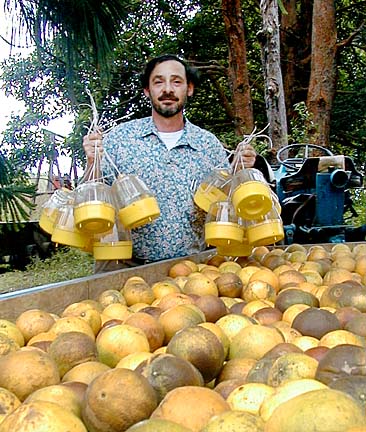Advertisement - Click to support our sponsors.


Orange grower NAALEHU, Hawaii -- In the war on bugs that attack his orchard, Big Island orange grower Morton Bassan wants more troops.
calls for bug
battalion
He wants to add to the good insects
that fight the bad in
his orchardBy Rod Thompson
Star-BulletinBassan has asked the state Department of Agriculture to approve importing thousands of helpful insects from six species to attack bad bugs at his orchard in Kau.
The new bugs would extend his "integrated pest management," in which Bassan relies on nature rather than chemicals to protect his crop.
An advisory committee of the Department of Agriculture has already recommended approval of Bassan's request. The full board will consider it on Jan. 25.
The insects are the Encarsia formosa, a whitefly parasite; Trichogramma minutum, a moth egg parasite; Chrysoperla carnea, green lacewing; Orius insidiosus, flower bug; Chilocorus circumdatus, a ladybug; and Geocoris punctipes, a bigeyed bug.
All of the species are already present on the Big Island. Bassan dropped a seventh he wanted when he couldn't find it at his orchard. All are small, some the size of a pinhead.
Bassan, who has a "few hundred" acres of oranges to protect, said the bad bugs get really bad only under certain conditions of heat and humidity. When that happens, the on-site good bugs attack them, but they need time to build up their numbers. Meanwhile, the bad bugs wreck Bassan's trees.
The good bugs can be readily bought from "insectaries" on the mainland. There are about 95 such facilities in the United States and more in Canada and Mexico.
The problem, said Larry Nakahara, manager of the state Plant Pest Control Branch, is that the quality of these labs varies. From experience, Nakahara knows some labs send just the right bugs, some send good and bad ones mixed, and some occasionally send a completely wrong bug.
The difficulty is that labs send the bugs in the forms of pupae, like cocoons, injected by female bugs into the pupae of bad bugs. Authorities at a quarantine station in Honolulu have to wait until adult bugs pop out of the bad bug pupae before they're sure what they have.
So Bassan faces a two-step process: first get import approval, then write conditions for making the imports. That basically means finding out which labs are reliable, Nakahara said.
When Bassan took over the old orange groves in 1980, he used insecticides, but their effectiveness gradually declined. Meanwhile, the chemicals killed good bugs as well as bad ones.
With careful monitoring, Bassan says he can use good insects to protect his orchards for a tenth of the cost of insecticides.
Monitoring means knowing when to release $4 worth of insects instead of waiting until he needs $4,000 worth, he said.
After the good bugs kill the bad bugs, they run out of food, die off, and are cleaned up by another set of good bugs, he says.
Another example of biocontrol are the ants and the aphids, he said. Aphids suck the juices of Bassan's orange trees. Ants like aphid juices so they protect the aphids.
Bassan broke the cycle by putting out bowls of honey mixed with boric acid. The ants took the honey to their queen and unwittingly poisoned her.
No queen, no ants, no aphids -- and no chemicals on the trees.
Besides attracting pests to poison, Bassan lets some munch on decoy plants. He shows caterpillars stripping a Chinese lantern plant bare of leaves while ignoring orange trees right next to it.
Rounding out the picture are Bassan's geese and ducks, which eat other bugs and weeds.
The more than 20 cats roaming the orchards -- Bassan has lost count -- are mainly for decoration.
Bassan started the transition from standard practices to biocontrol in the 1980s. He hopes to sell his oranges as being organically grown. He has now received "transitional" organic certification and expects final certification soon.